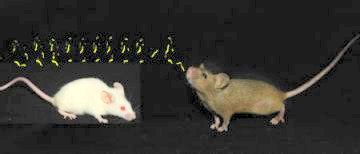Mouse Songs
Male mice appear to string together chirpy, high-pitched noises to create songs.
By Emily Sohn
For some people, the sight of a mouse can be reason to scream. For other mice, the same sight can be reason to sing.
Rodents will probably never sing their way to Broadway, but researchers from Washington University in St. Louis have found evidence that mice do, in fact, sing. Until now, crooning mice have starred in cartoons, but never before have they been heard belting it out in real life.
 |
|
Mice appear to string together “chirplike” ultrasonic noises (shown as a plot in yellow) to create songs. |
| Timothy E. Holy and Zhongsheng Guo |
Scientists already knew that mice make ultrasonic sounds—noises that are too high-pitched for people to hear without special equipment. Mouse babies cry out when they lose their mothers. Male mice make noise when they smell females.
To find out whether mice put such sounds together in song-like patterns, the researchers recorded the sounds of 45 male mice. They put each mouse in its own chamber with a urine-soaked cotton swab. The smell of the urine inspired them to make noise. Microphones recorded the sounds.
Using computer software, the researchers were able to separate the squeaks into specific types of syllables, based on how quickly the pitch rose or fell. The mice produced about 10 syllables per second.
The results showed that nearly all of the mice repeated sequences of syllables in distinct patterns. That’s enough to meet the definition of what scientists call song. Birds, whales, and people do the same thing.
Not all scientists are convinced that what the mice are doing is actually singing. To prove it, the researchers must show that there’s learning involved. And, they need to figure out why the mice sing. One guess, the researchers say, is that male mice use songs to woo females that they admire.
Nonetheless, the discovery that mice produce such complicated sounds could have important implications for the study of communication in animals, including people.
To hear various versions of mouse songs, visit http://www.sciencenews.org/articles/20051105/mousesongs.asp .—E. Sohn
Going Deeper:
Harder, Ben. 2005. Beyond falsetto: Do mice sing at ultrasonic frequencies? Science News 168(Nov. 5):293. Available at http://www.sciencenews.org/articles/20051105/fob5.asp .
You can hear various versions of mouse songs at http://www.sciencenews.org/articles/20051105/mousesongs.asp .
To learn more about how researchers studied mice and their songs, go to mednews.wustl.edu/news/page/normal/6040.html (Washington University School of Medicine) and www.eurekalert.org/pub_releases/2005-10/plos-mha102605.php (Public Library of Science).







